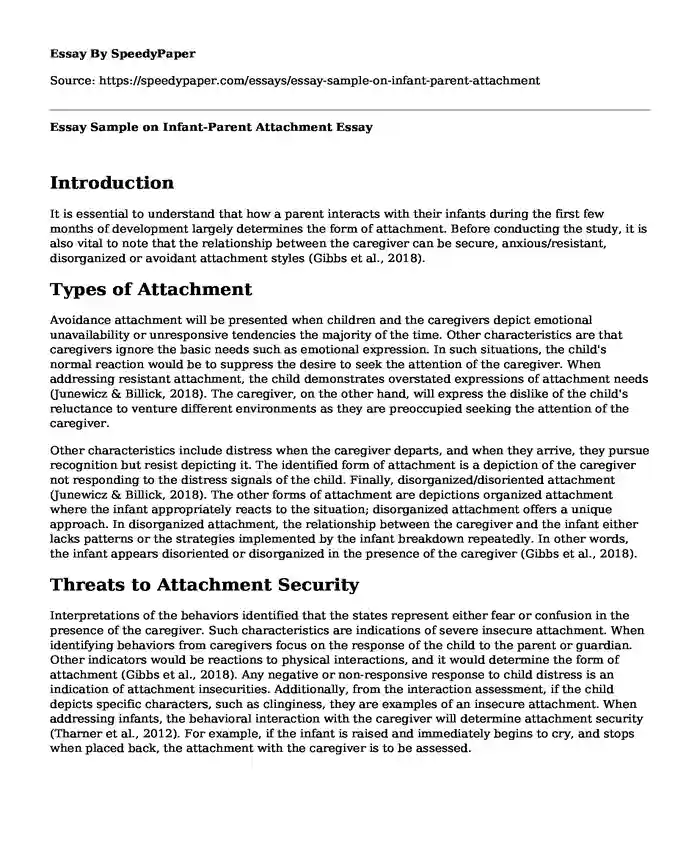
| Type of paper: | Essay |
| Categories: | Parenting Child development |
| Pages: | 3 |
| Wordcount: | 662 words |
Introduction
It is essential to understand that how a parent interacts with their infants during the first few months of development largely determines the form of attachment. Before conducting the study, it is also vital to note that the relationship between the caregiver can be secure, anxious/resistant, disorganized or avoidant attachment styles (Gibbs et al., 2018).
Types of Attachment
Avoidance attachment will be presented when children and the caregivers depict emotional unavailability or unresponsive tendencies the majority of the time. Other characteristics are that caregivers ignore the basic needs such as emotional expression. In such situations, the child's normal reaction would be to suppress the desire to seek the attention of the caregiver. When addressing resistant attachment, the child demonstrates overstated expressions of attachment needs (Junewicz & Billick, 2018). The caregiver, on the other hand, will express the dislike of the child's reluctance to venture different environments as they are preoccupied seeking the attention of the caregiver.
Other characteristics include distress when the caregiver departs, and when they arrive, they pursue recognition but resist depicting it. The identified form of attachment is a depiction of the caregiver not responding to the distress signals of the child. Finally, disorganized/disoriented attachment (Junewicz & Billick, 2018). The other forms of attachment are depictions organized attachment where the infant appropriately reacts to the situation; disorganized attachment offers a unique approach. In disorganized attachment, the relationship between the caregiver and the infant either lacks patterns or the strategies implemented by the infant breakdown repeatedly. In other words, the infant appears disoriented or disorganized in the presence of the caregiver (Gibbs et al., 2018).
Threats to Attachment Security
Interpretations of the behaviors identified that the states represent either fear or confusion in the presence of the caregiver. Such characteristics are indications of severe insecure attachment. When identifying behaviors from caregivers focus on the response of the child to the parent or guardian. Other indicators would be reactions to physical interactions, and it would determine the form of attachment (Gibbs et al., 2018). Any negative or non-responsive response to child distress is an indication of attachment insecurities. Additionally, from the interaction assessment, if the child depicts specific characters, such as clinginess, they are examples of an insecure attachment. When addressing infants, the behavioral interaction with the caregiver will determine attachment security (Tharner et al., 2012). For example, if the infant is raised and immediately begins to cry, and stops when placed back, the attachment with the caregiver is to be assessed.
Contextual Influences
The type of infant attachment determines the value of contextual information regarding the caregiver. The questions will focus on their personal, social and professional lives to identify stresses that may affect the attachment. The notion is based on a study by (Tharner et al., (2012) who recognized that parenting stress had more explicit effects on aggression and problematic attention behaviors from the infant. Such questions will include functional changes, or new relationships), among others. When the attachment is assessed from an emotional perspective, it identifies itself as a mutual relationship where the caregiver positively influences the developing infant. It is achieved through the interactions and relationship they possess (Tharner et al., 2012). To attain strong relations, the caregiver has to demonstrate responsiveness, care, and distress to situations appropriately among others. Infants cannot regulate themselves; the process is overwhelming as new environments already impose numerous emotional states (Tharner et al., 2012). The primary caregiver performs as a secure base that infants rely on for learning.
References
Gibbs, B., Forste, R., & Lybbert, E. (2018). Breastfeeding, Parenting, and Infant Attachment Behaviors. Maternal And Child Health Journal, 22(4), 579-588. https://doi.org/10.1007/s10995-018-2427-z
Junewicz, A., & Billick, S. (2018). Nature, Nurture, and Attachment: Implications in Light of Expanding Definitions of Parenthood. Psychiatric Quarterly, 89(3), 511-519. https://doi.org/10.1007/s11126-017-9554-3
Tharner, A., Luijk, M., van IJzendoorn, M., Bakermans-Kranenburg, M., Jaddoe, V., & Hofman, A. et al. (2012). Infant Attachment, Parenting Stress, and Child Emotional and Behavioral Problems at Age 3 Years. Parenting, 12(4), 261-281. https://doi.org/10.1080/15295192.2012.709150 R
Cite this page
Essay Sample on Infant-Parent Attachment. (2023, May 14). Retrieved from https://speedypaper.net/essays/essay-sample-on-infant-parent-attachment
Request Removal
If you are the original author of this essay and no longer wish to have it published on the SpeedyPaper website, please click below to request its removal:
- Essay Sample. The History of Information Communication Technology
- Essay Sample on Domestic Violence, Binge Drinking and Sexual Abuse in Family with Children
- Essay Sample on Erickson's Psychosocial Theory of Development
- Playtime: An Essential Element in Shaping Children's Future - Essay Sample
- Essay Example on Audience: Children
- Toy Project - Free Essay
- Free Essay. Main Arguments in "Second Chance Kids"
Popular categories




